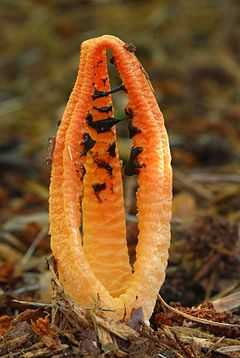Pseudocolus
| Pseudocolus | |
|---|---|
 | |
| Pseudocolus fusiformis | |
| Scientific classification | |
| Kingdom: | Fungi |
| Division: | Basidiomycota |
| Class: | Agaricomycetes |
| Order: | Phallales |
| Family: | Phallaceae |
| Genus: | Pseudocolus Lloyd (1907) |
| Type species | |
| Pseudocolus fusiformis Lloyd (1909) | |
| Species | |
|
P. fusiformis | |
Pseudocolus is a genus of fungi in the stinkhorn family. The fruit bodies have three or four simple arms that are initially joined at the tip, but often break apart. The tips of the arms are covered with a slimy, foul-smelling gleba, which attracts insects that help disperse the spores. The genus contains three species: the type Pseudocolus fusiformis, P. garciae, similar in appearance to the type but with a pinkish to red, rather than orange color, and P. grandis, found in India.
Taxonomy
The first appearance of the type species, Pseudocolus fusiformis, in the literature was in 1890, under the name Colus fusiformis, when Eduard Fischer wrote a description based on a painting he found in the Paris Museum of Natural History.[1] In his 1944 monograph on the Gasteromycetes of Australia and New Zealand, Gordon Herriot Cunningham considered this naming to be a nomen nudum—not published with an adequate description.[2] However, it was valid under the rules of the International Code of Botanical Nomenclature. In 1899 Penzig described the species Colus javanicus based on a single specimen found on Java,[3] and a year later Fischer amended the name of his original Colus fusiformis to Colus javanicus, as he was not satisfied with the quality of his original description.[4] Despite his doubts on the validity of his description, his original naming is both legitimate and has priority over C. javanicus.[5]
In 1907, Curtis Gates Lloyd described the new genus Pseudocolus, and reduced several species to synonyms of Pseudocolus fusiformis.[6]
Description
The fruit body consists of a flaring, short stipe surmounted by unbranched columns that bear the gleba and are normally united at the apex, occasionally becoming free. The tissue of the receptacle has a tubular structure.[7]
Species
Several species described as Pseudocolus have been reduced to synonymy with P. fusiformis, while others are poorly known and have been seldom reported in the literature since their original descriptions.
- Pseudocolus archeri (Berk.) Lloyd (1913)
- Originally described in 1860 by Miles Joseph Berkeley as Lysurus archeri ,[8] this name is one of many synonyms now lumped under Clathrus archeri (Berk.) Dring (1980)
- Pseudocolus fusiformis (E.Fisch.) Lloyd (1909)
- Originally Colus fusiformis E.Fisch.[1]
- Pseudocolus garciae (Möller) Lloyd (1907)
- Pseudocolus grandis J.A. Sáenz, Rawla & R. Sharma (1982)[9]
- Pseudocolus jaczewskii Woronow (1918)
- Described in 1918 from specimens collected by Voronoc in South Colchis; synonymous with P. fusiformis.[10]
- Pseudocolus javanicus (Penz.) Lloyd (1907)
- Pseudocolus mauritianus Lloyd (1917)
- Pseudocolus rothae (Lloyd) Yasuda (1916)
- Pseudocolus rothae Lloyd (1907)
- Pseudocolus schellenbergiae (Sumst.) Johnson (1929)
Distribution
Pseudocolis fusiformis is known from east Asia and Indonesia, Australia and New Zealand, and southern Africa, and has been introduced to the United States.[11] P. garciae is found in North America and South America.[7] P. grandis is found in both northern and southern India.[12]
References
- ↑ 1.0 1.1 Fischer E. (1890). "Untersuchungen zur vergleichenden Entwicklungsgeschichte und Systematik der Phalloideen. I". Neue Denkschriften der allgemeinen Schweizerischen Geseallschaft für die gesammten Naturwissenschaften (in German) 32: 1–103.
- ↑ Cunningham GH. (1944). The Gasteromycetes of Australia and New Zealand. Dunedin, New Zealand.
- ↑ Penzig O. (1899). "Über javanische Phalloideen". Annales du Jardin Botanique de Buitenzorg (in German) 16: 133–73.
- ↑ Fischer E. (1900). "Untersuchungen zur vergleichenden Entwicklungsgeschichte und Systematik der Phalloideen. III". Neue Denkschriften der allgemeinen Schweizerischen Gesellschaft für die gesammten Naturwissenschaften (in German) 36: 1–84.
- ↑ Blanton RL. (1976). "Pseudocolus fusiformis, new to North Carolina". Mycologia 68 (6): 1235–9. doi:10.2307/3758756. JSTOR 3758756.
- ↑ Lloyd CG. (1907). "Concerning the phalloides". Mycological Notes 2 (28): 349–64.
- ↑ 7.0 7.1 Dring DM. (1980). "Contributions towards a rational arrangement of the Clathraceae". Kew Bulletin 35 (1): 1–96+ii. doi:10.2307/4117008. JSTOR 4117008.
- ↑ Hooker JD. (1860). Botany of the Antarctic Voyage. III Flora Tasmaniae 2. p. 264.
- ↑ J.A. Sáenz, Rawla & R. Sharma, 1982, Revista de biologia tropicale 30(1):102.
- ↑ Burk WR. (1978). "Pseudocolus fusiformis: synonymy and distributional records". Mycologia 70 (4): 900–5. JSTOR 3759379.
- ↑ Kibby G. (1994). An Illustrated Guide to Mushrooms and Other Fungi of North America. London, UK: Lubrecht & Cramer Ltd. p. 158. ISBN 978-0-681-45384-5.
- ↑ Kumaresan V, Ganesan T, Rajarajan D. (2008). "Pseudocolus grandis from Southern India". Mushroom Research 17 (2): 69–70. ISSN 0972-4885.